|
|
|
Sort Order |
|
|
|
Items / Page
|
|
|
|
|
|
|
| Srl | Item |
| 1 |
ID:
101273
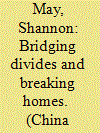

|
|
|
|
|
| Publication |
2010.
|
| Summary/Abstract |
This article highlights the case of a rural north-east Chinese village where youth labour mobility is a marriage strategy deployed by parents and engaged in by young people given constraints on education and income in the countryside. While some rural mothers and their daughters do make the fairytale of "marrying-up" into an urban household come true, for most rural young women migrants the self-oriented consumption that they are encouraged to pursue free of rural domestic responsibilities sets them up for heartbreak when they are brought back for a rural marriage. As long as rural households are left to rely on the "insurance" of land and a younger generation to work it and provide labour of domestic subsistence, they will pull sons (and wives for them) back to the countryside, and try to marry daughters to urban households to expand their network of security. This new twist on an old managerial strategy sets up a tragic conflict: young men are encouraged to return to the countryside, while young women are pushed to provide a "uniting bridge" into the city and, when they fail, are brought back to the countryside for marriage. If the experiences of families in Huangbaiyu village are not an anomaly but signal a broader trend, a generation of returnee young women who are frustrated and angry in rural marriages and abandon their husbands and parents-in-law will dramatically influence the future of China's development.
|
|
|
|
|
|
|
|
|
|
|
|
|
|
|
|
| 2 |
ID:
170254
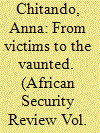

|
|
|
|
|
| Summary/Abstract |
Reflecting on young women involved in violence/peace, the dominant views present them as victims. This is understandable, as young women constitute the majority of those who are at the receiving end of violence. Further, young people are generally regarded as a threat. However, this paradigm glosses over the contribution of young women to peacebuilding in their communities. Despite the UN Security Council Resolution 1325 calling for women’s equal participation and full involvement in all efforts for the maintenance and promotion of peace and security, major challenges of its implementation in Africa remain. Therefore, this study sought to establish young women’s understanding of peacebuilding, activities they undertook to contribute to peacebuilding in Mashonaland East in Zimbabwe, and the challenges they encounter. The study prioritised the agency of young women in contributing towards peace in Mashonaland East, Zimbabwe. The research was based on the qualitative method as it sought to establish how women participate in peacebuilding. Findings of the study showed that young women are contributing to peacebuilding, although they face some challenges.
|
|
|
|
|
|
|
|
|
|
|
|
|
|
|
|
| 3 |
ID:
125954


|
|
|
|
|
| Publication |
2013.
|
| Summary/Abstract |
QUITO, Ecuador-The prosecutor stands to deliver her opening statement in the case. She wears a tight, electric-blue dress that comes to mid-thigh. Standing on her matching stiletto heels, she turns toward the three-judge panel at the front of the room and lays out her case against the defendant. The defendant, she begins, had cut down an ancient and valuable tree, thereby committing a crime against the property owner and the state. Her opening statement is short, mostly read from the page in front of her. The judges, two middle-aged men and a young woman in her early 30s, listen intently from their seats behind a folding table. They face the audience, crammed into two narrow rows at the back of the room, and are flanked to the left by the prosecution team and to the right by the defendant and his lawyer, all seated at creaky folding tables. The defendant-a dark-skinned, middle-aged man in a short-sleeve button-down blue shirt-sits listlessly, his arms folded across his chest. His lawyer takes occasional notes during the opening statement, but mostly looks down at the thin binder before him. Everyone in the room-audience, judges, and lawyers-sits in folding chairs. Next to the judges is the clerk of the court at a computer. Besides that, the room is barren.
|
|
|
|
|
|
|
|
|
|
|
|
|
|
|
|
| 4 |
ID:
184766
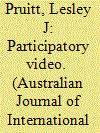

|
|
|
|
|
| Summary/Abstract |
This article considers the implications of incorporating participatory video in International Relations (IR) research. Drawing on existing aesthetic and visual IR research, I critically reflect on a case study incorporating participatory video in research investigating young women’s leadership in Asia and the Pacific. Through participatory video, young women redressed their common invisibility and challenged portrayals situating them as unable to lead and make decisions. In this way, participatory video disrupted and unsettled power relations often resulting in young people’s marginalisation from policymaking. Given its ability to make space for productive reflections on, and challenges to, existing power dynamics amongst and between researchers, research participants, and the state, participatory video can productively push the boundaries of IR research. Limitations and challenges of using participatory video are also evident and require reflection. Overall, I suggest that participatory video can generate new critiques and knowledge to productively shape current and future IR research, including through offering unique insights that could be missed by other methods in IR, including other filmmaking approaches.
|
|
|
|
|
|
|
|
|
|
|
|
|
|
|
|
| 5 |
ID:
118363


|
|
|
| 6 |
ID:
160380
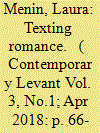

|
|
|
|
|
| Summary/Abstract |
Over the last decade, the mobile phone has become an integral part of a subterranean ‘youth culture’ of romance in urban Central Morocco. By expanding the opportunities of male–female interaction, the mobile phone enables young women to explore the possibilities of emotional and physical intimacy beyond conventional rules of courtship. The desire for premarital romance, though, collides and interweaves with conventional gendered practices and moralities, as well as with the new religious sensibilities that have emerged with the Islamic revival. Tracing the ways Zahra and Yasmin, two unmarried women in their early 20s, mediate dynamics of flirting, seduction and jealousy via the mobile phone, the author shows how they affirm their respectability through and not in spite of their intimate mediated practices. Far from being only a powerful ‘mediator’ between intimate desires, social expectations and public morality, the mobile phone reveals itself as integral to the ways Zahra and Yasmin reflect on, and act in, their intimate and moral worlds. The author hopes to contribute to ‘gendering’ anthropological debates on ‘everyday Islam’ by showing the nuanced ways in which young women in Central Morocco use the mobile phone to shape their intimate lives, navigating competing femininities and gendered moralities.
|
|
|
|
|
|
|
|
|
|
|
|
|
|
|
|
| 7 |
ID:
147068


|
|
|
|
|
| Summary/Abstract |
This paper focuses on the changing definition of marriage for young women in Tokyo over the last 10 years. Based on fieldwork research conducted in Tokyo, I examine why women are delaying or refusing marriage, arguing that women’s decisions can best be understood in relation to work. I discuss how young women negotiate their conception of marriage by articulating their desires for self-realization, a career, and participation in society, within the context of a flexibilization of work and the transformation of family in contemporary Japan.
|
|
|
|
|
|
|
|
|
|
|
|
|
|
|
|
| 8 |
ID:
174412
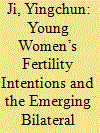

|
|
|
|
|
| Summary/Abstract |
China’s total fertility rate (TFR) has been below replacement level since the 1990s and below 1.5 since the 2000s. To address the issue of low fertility and rapid aging, the Chinese government replaced the strict one-child family planning policy with the selective two-child family planning policy in 2013 and then the comprehensive two-child family planning policy in 2015. However, a strong baby boom did not ensue, and births hit a record low in 2018. It is thus vital to understand fertility motivation among younger generations of women. Collecting qualitative data in a small city in the Yangtze Delta, we found that the high costs of current practices of child raising and education are prominent factors in women’s mind-sets, and that bilateral family support, including but not limited to help with finances and care, is the cornerstone of this expensive, modern child raising model. A complex, bilateral family model has gradually grown out of the patriarchal system. Grandparents on both sides collaborate with the mother at different times of the day and in different stages of children’s development. A familial relay race of child care reduces the mother’s work-family conflicts. The sustainability of mosaic familism, the gendered intergenerational collaboration following bilateral family lines, is questionable, particularly when raising children comes into conflict with caring for the elderly. We suggest that future policies pay sufficient attention to the needs of women who are embedded in the bilateral extended family.
|
|
|
|
|
|
|
|
|
|
|
|
|
|
|
|
|
|
|
|
|